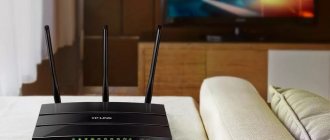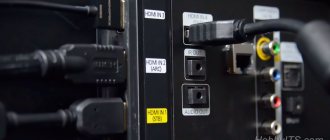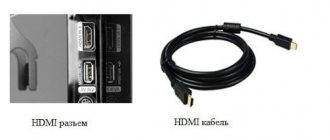What does twisted pair and Wi-Fi have to do with it?
Dear reader, I have a free blog here - so if everything is not interesting, immediately scroll through the Contents to the sections of the article that interest you. I'll start from afar. In a galaxy far, far away...
The fact is that the central element of a home Wi-Fi network is now a router. A modern router usually has wired connections:
- From the router to the provider's network - the same cable from the entrance. There is regular Ethernet and telephone under ADSL - all these wires are called “twisted pair”. The first occurs more often, the second less and less often.
- From a router to a computer or laptop - sometimes the connection is made not via Wi-Fi, but via wire. Likewise, computers without an adapter can be connected to the Internet, and seasoned players say the ping will be better.
So in a home network there is nowhere without a twisted pair cable.
Cable crimping
But we should not forget that the connection between just two devices is also a network. Moreover, such a connection can raise no less questions than a star connection, due to the fact that some cable pairs in RJ45 connectors (or, as they are also called, “jacks” from registered jack) most often have to be swapped.
The order of communication lines in the form of twisted pair wires in the RJ45 connector, and, consequently, in the device’s network adapter port after connecting a cable with a connector to it, is determined by the physical device of this very port. A standard port is a hole with a groove for fixing an RJ45 connector inside it and eight contacts in the form of metal strips that exactly match the strip contacts on the connector. These contacts have their numbers from 1 to 8 (see Fig. 2) and are divided into pairs: 1-2, 3-6, 4-5, 7-8. There are two types of ports—MDI (Medium Dependent Interface) and MDI-X (Medium Dependent Interface crossover)—each with pin pairs 1-2 and 3- 6 have different purposes, but simply change places. That is, if in the MDI port pair 1-2 are the data transmitter contacts (Tx), and pair 3-6 are the receiver contacts (Rx), then in the MDI-X port it is the other way around: pair 1-2 are the receiver contacts (Rx) , and 3-6 - the transmitter (Tx), as indicated by the letter “X” in the name of the port. For a connection between two devices to work, the transmitter (Tx) of one device must be connected to the receiver (Rx) of the other device.
| a) photo 8p8c (RJ45) | b) MDI/MDI-X port | c) RJ45 connector |
Rice. 2. Numbering of contacts
Most network adapters and other devices are equipped with MDI ports. Devices such as switches are equipped with MDI-X ports specifically so that when any device is connected to them, the twisted pair can be crimped equally on both sides, without crossing the pairs inside the cable. There are hubs with auto-pin detection that decide for themselves whether a port should be MDI-X or MDI, depending on the device connected to that port. Many switches are connected to each other by a simple cable without crossing through special ports called UpLinks (see Fig. 3). Another connection method is the ports, which can act as both an MDI-X port and an MDI port, depending on the position of a special switch or button.
Rice. 3. Switch with UpLink port
Problem
One of the most common reasons for the loss of Internet at home is a cable problem. There are many options:
- A wire has frayed somewhere in the corner connections - it happens that someone shuffled it or kicked it.
- The connection in the connector is broken - the wire there is open, so it may break. Sometimes the connection just drops. And over time, the crimp “dries out,” so you still have to improve the connection.
The bottom line is that when replacing a wire or repairing a connector, you still have to somehow reattach those same connectors. But this procedure is called crimping. And you can do this completely at home yourself (I’m telling you as a seasoned admin, and it wasn’t in times like these that you were cutting the cable). But you need a little theory - this is not electrical wiring. So first, a little theory, and then let's move on to practice.
Twisted pair crimping process
Well, it's time to find out how to properly crimp a twisted pair cable. Let's start this stage right now. We measure the cable and cut it with a margin of 0.5 meters. To avoid damaging the internal conductors, do the following: make a small cut on the protective sheath, and then simply bend it in this place. The sheath will burst at the cut site; cut off the wires with wire cutters.
- We measure 20 mm from the edge and remove the insulation of the wire.
- We unwind all the wires and sort them according to the scheme (which you have decided on).
- We tightly clamp with our fingers all the veins laid out according to the colors of the diagram and bite off evenly with wire cutters.
- We take the RG 45 plug, turn it over so that the latch is facing down and slowly insert all the wires into the connector. They should fit evenly into the grooves. Doesn't work the first time? No problem, let's try again.
- Without fanaticism, we push the wires evenly to the end until you feel that they are resting. Visually check if all the cores have reached the end. The protective sheath must also fit into the plug; it must be clamped when crimped.
- Holding the connector with the inserted twisted pair, slowly insert it into the clamping pliers (crimper). Squeeze with your hand. Everything is ready, everything turned out great.
We perform crimping without tools
The process will be different due to the lack of a special tool for crimping. You don’t have to make unnecessary expenses, buy pliers, in order to crimp the cable with rj 45 a couple of times. The method is that the crimper function will be performed by a screwdriver or an ordinary knife. After all the wires are inserted, take a screwdriver and apply it to the metal contacts on the connector, pressing lightly. This will need to be done with each contact.
Crimping a toolless connector
There are connectors for which pliers are not needed. Here you just need to press well with your fingers and that’s it. True, the price for such a plug is not at all small. Therefore, we should think about whether it is worth it. The principle of crimping is simple, we insert each core into the grooves from above, after all the wires are laid, close both halves of the housing tightly. Such connectors are produced in Russia by SUPR.
twisted pair
In the last section, we found out that twisted pair is a wire used for network connections in computer technology. Especially used at home to connect to the Internet.
It got its name from the building. Inside there are copper wires in a sheath, twisted in pairs. Twisting is done with a certain step depending on the number of such pairs. The whole point of such twisting is mutual cancellation of interference to improve the quality of the signal in the working network (after all, this wire also carries electricity, although not 220V, and reliability here is needed at a high level, but this is a topic for standards).
There are several types of twisted pair... Even many. The main classification is by device, not the main one - by protection. When installing at home, you will usually be dealing with a category 5 cable (if you want, look for it yourself, that’s not what the article is about).
In terms of protection, there is also nothing difficult - there is with protection, there is without protection. Protection does not mean from falling stools, but from the same interference that creates interference. This is usually not required at home, but you never know what you can get your hands on. The section is larger for the fact that you will have to open the cable during crimping, and you need to be prepared for anything) So a little anatomy for the system administrator and the home enthusiast to surf VKontakte.
So, there are pairs of wires inside - usually 2 or 4. The wire can be protected - we are talking about foil or braid. In this case, protection can be either for the whole wire or separately for each pair. There are a lot of subtleties, it’s better to open it right away and look locally. In home cable there is usually nothing like this - one braid, and there are pairs in it at once.
Twisted pair markings:
- UTP – regular, without protection, for home. If you need to restore a piece of your house and go to the store, just look for something like UTP5 - it will do just fine.
- FTP - with foil, also sometimes used indoors.
- SFTP – metal braid, used outdoors.
- STP – protection on each pair. When the wire is on the street near power lines (I hope you didn’t get caught there).
In total, the different options are arranged in the following figure:
An additional bonus is that there are multi-core and single-core cables. Stranded ones are used at home - the wire comes out flexible, just for active movements. It is better to use a single-core wire for industrial installation - up to the socket, the wire does not bend, but the signal transmission is much better.
I don’t even want to mention flammable and non-flammable, round and flat here - after all, this is not a system administrator’s textbook, but simply helping those in need at home. So if you have questions, run to the comments.
Attention! Leave your comments. We will help everyone!
General information
Very often there is a need to wire a home network of devices with Internet access. Solving the problem is very simple, since you need to purchase a router, configure it and connect all devices to it. In this case, cable crimping is necessary. There are two ways out of this situation: seek help from a specialist or perform the crimping yourself. Crimping a network cable is inexpensive, but in some cases it can be unprofitable, since you need to adjust and wait for a specialist to arrive.
In some cases, for convenience, you need to use your home network, since it is not very convenient to run with a flash drive from one computer to another and download your favorite show or movie. To do this, you need to know how to properly crimp a twisted pair with 8 cores.
Types of twisted pair
Twisted pair is a special cable consisting of a certain number of copper wires in a sheath, and they are twisted together in a certain way. The wires are twisted in a certain way in order to eliminate their influence on each other. Twisted pair cable is used for data transmission. The network cable is connected to devices through special connectors using connectors.
An Ethernet cable can be with or without protection. The protective sheath is made of aluminum foil or sheath (braid). Protection can be of two types: general and pairwise. General protection applies to the entire cable, and pairwise protection only to each pair. The network cable can be divided into several types:
- UTP.
- FTP.
- STP.
- S/FTP.
- S/STP.
- SF/UTP.
Types of network cables marked UTP (unshielded) or FTP (common foil shield) can be used indoors. If you need to lay communications outdoors, you should use an SF/UTP cable. If the Internet wire is laid together with an electrical cable, it is necessary to use STP or S/STP, which provides protection for each pair and a double screen (length more than 100 m). The S/FTP cable (each pair and the cable itself is shielded) is designed for use in environments with high noise levels.
Each core of an Ethernet cable can consist of one (single-core) or many (multi-core) conductors. Single-core wires bend poorly, but have improved characteristics that affect the signal transmission distance. They crimp better, are fixed and practically do not bend. A network cable, the cores of which consist of one conductor, is used to connect Internet outlets.
Twisted pair wires, the wires of which contain many conductors, bend well, but have high attenuation during signal transmission. It is difficult to crimp it because you can cut through the insulation. It is difficult to insert into the connector and is used in cases where flexibility is important (from an Internet outlet to a personal computer).
Category and containment
The twisted pair category is very important. To connect to the Internet or conduct communications for a computer network, you should use a category of at least CAT5. In exceptional cases, CAT6 and CAT6a are suitable. Category designations are embossed on the shell. There are a total of 7 types of categories for twisted pair:
- I - 1 pair (bandwidth 0.1 MHz): used in telephone communications.
- II - 2 (1 MHz): networks with data transfer rates up to 4 Mbit/s.
- III - 4 (16 MHz): 10 and 100 Mbit/s.
- IV - 4 (20 MHz): up to 16 Mbit/s.
- V - 4 (100 MHz): 100 Mbit/s (2 pairs are used).
- Ve - 4 (125 MHz): 100 Mbit/s (2 pairs) and 1 Gbit/s (4 pairs).
- VI - 4 (250 MHz): from 1 to 10 Gbit/s.
- VII - 4 (600 MHz): shielded up to 10 Gbit/s.
You might be interested in this Marking and characteristics of the VVG copper multicore cable
Twisted pair also differs in the shape and color of the sheath. The common type of power cord is gray sheath. The orange (bright red) color of the sheath indicates that the power cord does not support combustion. The latter type of wire makes sense to use in areas prone to fire. In addition, twisted pairs are flat and round. They do not differ in technical characteristics.
The Ethernet cable consists of 2 (4 wires) or 4 (wires) pairs. At speeds up to 100 Mbit/s, 2 pairs can be used. If the data transfer rate is in the range from 100 Mbps to 1 Gbps (1000 Mbps), then all 8 wires (pairs) should be used. When designing your home network or connecting to the Internet, you should take these features into account. It is better to stretch 4 pairs at once, since if the information transmission speed increases above 100 Mbit/s, you will have to re-tighten the cable.
Wire selection and standards
In the last section I mentioned the categories of twisted pair, here we will consider this point in a little more detail. After all, the anatomy and transmission speed on the cord also depend on the category.
I recommended that you take category 5, but category 6 (CAT5, CAT6) is also suitable. All options are shown in the following table:
It will be important to choose a cable for the required speed. And this also depends on the number of wires inside. It usually happens like this:
- 2 pairs (4 wires) – up to 100 Mbps
- 4 pairs (8 wires) – from 100 Mbit/s
Typically, ISP technology limits you to 100 Mbps internet speed. But soon this threshold will be passed. What do I mean - usually there will be exactly 2 pairs on the Internet cable, but on home cables (from the router to the computer) there are already 4 pairs.
4 pairs, or 8 wires
Crimping theory
And now we are approaching the crimping procedure. But there is still something to clarify, the final frontier.
You have all seen the connector at the end of a twisted pair cable, which also goes into the network connector of a network card or router. This plug has a special marking. The one that is mainly used now in the home local network is RG-45. A little about the connector design and connection.
- The twisted pair is installed in the connector socket.
- The twisted pair wires are routed through special grooves in the connector.
- The contact mechanism of the connector is knives. In store condition, they are separated, providing a path for the cable wires.
- When crimping, apply pressure to the knives, and they cut through the sheath and ensure tight contact with the wire cores.
- On the other hand, the contacts of the knives remain open - they provide a connection to the network adapter when connected.
Here is a picture of how the knives work:
And here is the connector in an enlarged view (the same wire tip or “jack”):
This connection is reliable and transmits the signal perfectly. But beginners may not be able to do enough at first - and either there will be no connection, or it will be established at a low speed (this is one of the reasons for the decrease in speed on the network). The best way to fix it is to squeeze it harder again, or re-press it again. In practice, at our university this procedure did not work out for everyone the first time - so everyone starts somewhere.
Crimping twisted pair with a screwdriver
You can crimp a network cable without a crimper. If you don’t have a special tool at hand, you can use a regular flat-head screwdriver.
You can really crimp it reliably with a screwdriver - there’s nothing complicated here, the main thing is to properly align the wires in advance so that they fit evenly and stay in the connector, and then carefully press the metal plates with a screwdriver, turning them over and placing the connector on a flat surface. You will clearly feel that the pressure is enough - the braid is broken and the wire is securely fixed. You need to press with the tool until the latch stops protruding beyond the edges of the connector. Only in this case will the electrical wire be securely fixed and secured.
Tools
The main thing when crimping is to make a high-quality cut with knives on the shell. And for this you need to create the right strong pressure on the contacts. Well, we couldn’t do it without creating tools, although we can do without them.
Pros use a special tool - crimping pliers, or crimper. I’ve also seen names like “wire crimpers” or “connector crimpers.” Here, who already has what taste, you will probably hear some other versions.
This thing isn't that expensive. You can find a working copy for less than 1000 rubles. For a one-time repair at home, the thing is useless. But their main feature is their functionality tailored for twisted pair cables:
- Cut the braid exactly to the level of the wires
- Stripping wire insulation down to the core
- Simultaneous crimping of all knives with the required force
- Sometimes there is a socket for crimping and telephone cable (RG-11)
This is what they look like:
No tool
In my life I have seen many crimping methods. But the most interesting of them was teeth, because... a person’s mother-in-law was a dentist... So sometimes you don’t even need a tool at all.
Another handy tool that everyone has is a screwdriver. Moreover, this is perhaps the most popular tool at home. The main thing is not to break anything and push through the contacts efficiently. If the connection is not established during the test, you just need to try again. The working method is difficult, everything constantly slides off - but without fish there is fish.
Another home helper is pliers. But my advice is that it’s better to suffer with a screwdriver. The pliers do not provide strong indentation (especially in the middle), and with great Russian heroic prowess they easily break the connector into small pieces.
Crimping diagram - pinout
And now the science itself. It’s one thing to apply pressure, another thing is to correctly insert the wires into the cores (and this is the most important thing in order to correctly crimp a twisted pair), and into both connectors - a random set will not work here. The order is very important. In total, the connector has 8 grooves for 8 cores. If 4-core wires are crimped, some of the grooves are left empty, the main thing is to get it right.
First, let's look at the classic crimping of an 8-core wire. There are 2 ways:
- Direct cable crimping (type B, 568B) is used in 99% of cases. Used to connect peripheral devices to a router/hub/switch.
- Cross crimp (crossover, type A, 568A) - used for direct computer-to-computer connections.
For reference . Now modern adapters understand both of these methods, but the first option of direct crimping remains preferable.
The names of twisted pair crimping circuits are taken from the way the wires are arranged in relation to each other. Look at the images below and you will understand everything. The main thing here is a view of the connectors from below (where there is no leg).
Direct crimp
Use this pinout diagram!
If the pictures are suddenly unavailable for some reason, the arrangement by color is:
1. White-orange 2. Orange 3. White-green 4. Blue 5. White-blue 6. Green 7. White-brown 8. Brown
Cross circuit
Four wires
Another option for 4 cores is the case when there are only 2 pairs. This is how they usually do it:
The whole point of proper pinout is to match the wires on both sides of the cable, without even knowing how the connector on the other side was crimped. An unspoken standard where you don’t have to run to the provider’s shield. The numbers 1-8 in the pictures are sometimes squeezed out on the sockets, this is for those who do not want to confuse the order.
Ethernet cable crimping
Crimping is required to connect one peripheral device to another. Any twisted pair ends with a special RJ-45 connector. The cores of the network cable are inserted into its grooves. The grooves end with contact plates made of copper, perpendicular to which metal plates (knives) are located. During crimping, when crimping with a crimper, the knives pierce the wire insulation and ensure reliable contact of the wire with the copper plate. The reliability of the connection can be equated to the wiring, but there are important points.
Basic methods
Crimping of a twisted pair of 8 cores should be done using the correct technology method, since the network will not work due to poor-quality contact. To crimp an Internet cable, use a special crimper with a socket for RJ-45 or pliers, which are also called “crimpers.” A connector with wires is inserted into the socket and the pliers are squeezed until it stops. Crimping pliers are a useful tool, but you can do without them. An alternative is a screwdriver and pliers.
Pliers can not only crimp, but also perform other functions: strip wires of insulation, bite off excess cable, carefully straighten wires, and crimp a telephone cable with an RJ-11 connector. Crimping an ethernet wire is not very convenient, but it is possible. To do this, you need to perform a certain sequence of actions:
- Strip the cable.
- Insert the cores according to the appropriate crimping pattern for the RJ-45 twisted pair.
- Press down on each knife.
You may be interested in this Features designation of phase and zero
This method has some disadvantages: the screwdriver constantly slips, the wire may be damaged, and it is impossible to control the cutting of the sheath of the power cable with a knife. You can perform the crimping procedure using pliers. However, this method is not very convenient, since there is a high probability of damaging the plastic housing of the connector. It is necessary to press on each side. If the middle is not pressed completely, it is recommended to use a screwdriver.
Pinout diagram
The wires in an RJ-45 connector must be arranged in a specific order, called a pinout. There are two types: straight and crossed (cross-over). The first is abbreviated “568B”, and the second (cross-over) is “568A”. Direct pinout is used when connecting a switch (hub, router) to a personal computer or other device. The cross-over type is only necessary to connect two computers directly. The order of wires when crimping is as follows:
- White-orange (b-o) - b-o.
- Orange (o) - oh.
- White-green (b-z) - b-z.
- Blue (c) - s.
- White-blue (b-s) - b-s.
- Green (g) - g.
- White-brown (b-k) - b-k.
- Brown (k) - k.
The wires on the two connectors are arranged identically. It is necessary to correctly crimp the 8-core Internet cable, and the important point is to strictly adhere to the order of the wires. Before crimping the power cable, you should double check it several times. If for any reason the color wires are reversed, the AC adapter may be damaged because power may be supplied through the AC cable. When connecting two computers or laptops into a network, you need to use the “568A” scheme:
- B-o - b-z.
- O - z.
- B-z - b-o.
- S - s.
- Bss - bss.
- Z - o.
- B-k - b-k.
- K - k.
For an Internet cable consisting of 4 cores, the wire layout does not change. In this case, only 1, 2, 3 and 6 grooves are used: white-orange - white-orange, orange - orange, white-green - white-green and green - green, respectively. The 4-wire connection method is used only for connecting various peripheral devices. The numbers from 1 to 8 are embossed on each connector.
Crimping procedure
Now let's move on to the correct way to crimp the cable. Be careful when working - the main thing is not to damage yourself, and the connectors are cheap)
Step 1. Remove the insulation
First, remove the insulation from the wire - you can carefully pry it off with scissors or use a stripper on a crimper - insert it, turn it, and the wrapper comes off. It is fragile and can be removed quite easily. You don't need to remove much insulation - a couple of centimeters from the end is enough. If anything happens, you can trim everything later. The pliers have special marks indicating at what level the coating should be cut.
Step 2. Straighten the wires
Now we take our wires, straighten them and arrange them according to the pinout diagram. From the recommendations - try straightening them with a pencil or hand - they become smooth and closely spaced to each other - which is what we need.
Step 3. Trim
Now is the time to cut and straighten our wires. We cut it either with wire cutters, or with the same pliers, or even with a knife. Leave about a centimeter of clean wire. With practice, you will learn to accurately check the distance.
Step 4. Getting into the connector
The hardest part. Now we need to insert our design into the connector. When inserted, the connector is positioned with the leg down. Why is it difficult - the wires try not to fall into their grooves, they crawl into neighbors, bend, and get tangled. Here the recommendation - patience and once again paying attention to the pencil treatment - helps.
Step 5. Insert all the way
After the hit, we press on the cable so that the wires go all the way. In this case, the wrapper will be hidden in the connector itself. If the wrapper does not fit into the connector, fractures are possible in the future. If the opposite turns out to be short, the wires will not reach the knives. So everything is done with experience and by eye.
Step 6. Crimping
Now is the time to tighten our knives - the methods were discussed above, but it is better to use pliers. Take it and live it.
Step 7. Check and refinement
Be sure to check the connection on your computer or router before putting away your tools. Sometimes it may not work out the first time. The easiest way to correct the situation before getting upset is to squeeze the knives again, but harder. It helps a lot.
If there is no connection, pay attention to this:
- Are the wires routed exactly according to the diagram? Didn't they fly out? Look through the connector.
- Have the wires reached the stop of the connector? Were the knives able to reach them?
The rest can only be attributed to cable failure.
Initially, before crimping the network cable, you can install these casings. They perfectly protect against bending near the connector, but in practice everything works without them. There are a lot of species, that’s not what the article is about. For reference.
What will you need for crimping?
Multimeter - to check the quality of crimping.
Video lesson: crimping an RJ connector Thanks to the advent of the Internet, many problems can be solved quite quickly, especially after watching videos. Stripper is a special hand tool for stripping insulation from conductors.
Almost all modern local networks use an RJ connector for connections.
Color scheme for crimping RJ 8P8C utp twisted pair cable computer - hub during repair If, when checking the twisted pair cable, a break or short circuit is detected in the orange or green twisted pair, and the blue and brown ones are working, then you can do without replacing the cable. To crimp such a cable, special RJ connectors are used. Their peculiarity is that you can connect more than one computer to one socket.
How to properly connect the Internet cable to an outlet. Connection diagram for RJ 45
The protective insulation is removed from the cable by about a cm. Cables are divided into two types: shielded and unshielded and are designated as follows: Color schemes for crimping in an RJ plug There are several schematic solutions for crimping twisted pair cables, which will be discussed below using the example of an Internet cable, used to build LAN and DSL networks.
This connection method has become somewhat less widespread. You can also connect a ready-made patch cord to the equipment and check whether all packages are received. There is no need to strip thin wires.
Connecting Legrand Internet sockets with a cable (diagram)
In order to do this, you first need to unravel the wires and align them, and then lay them side by side in the correct sequence and press them together as tightly as possible. Cross crimping tool, used when connecting sockets, patch panels, etc.
Its length is left sufficient to carry out the necessary work. Moreover, such specialists will charge a considerable amount for this. This type of connection was demonstrated in Figure 12 V. How to connect two routers to the same network using a cable
Examination
There are also options to check the cable connection. The key is to get both ends. In practice, this does not always work out at home - after all, the provider will not give you his end of the line. Therefore, it’s easier to check on the device - if everything works, then it’s great. No - we are looking for a different reason.
LAN testers are used professionally. This device shows for sure which vein has a signal and which does not:
Additionally, you can use a multimeter, but here you will have to ring each wire separately. But what can you do, because Russian people can do everything)
Thank you all for your attention! If you still have questions, write in the comments. We press, we press and we will press)











